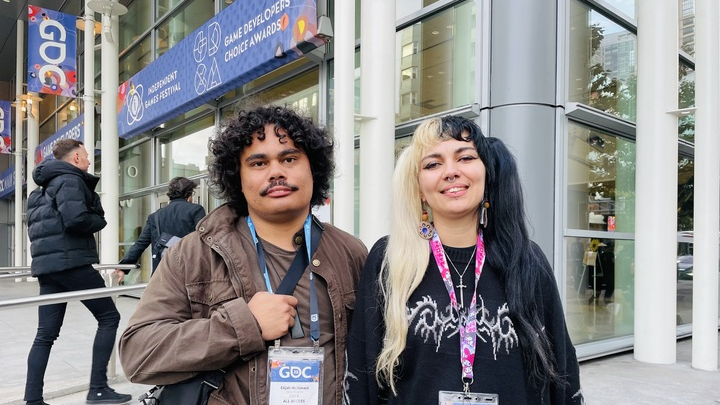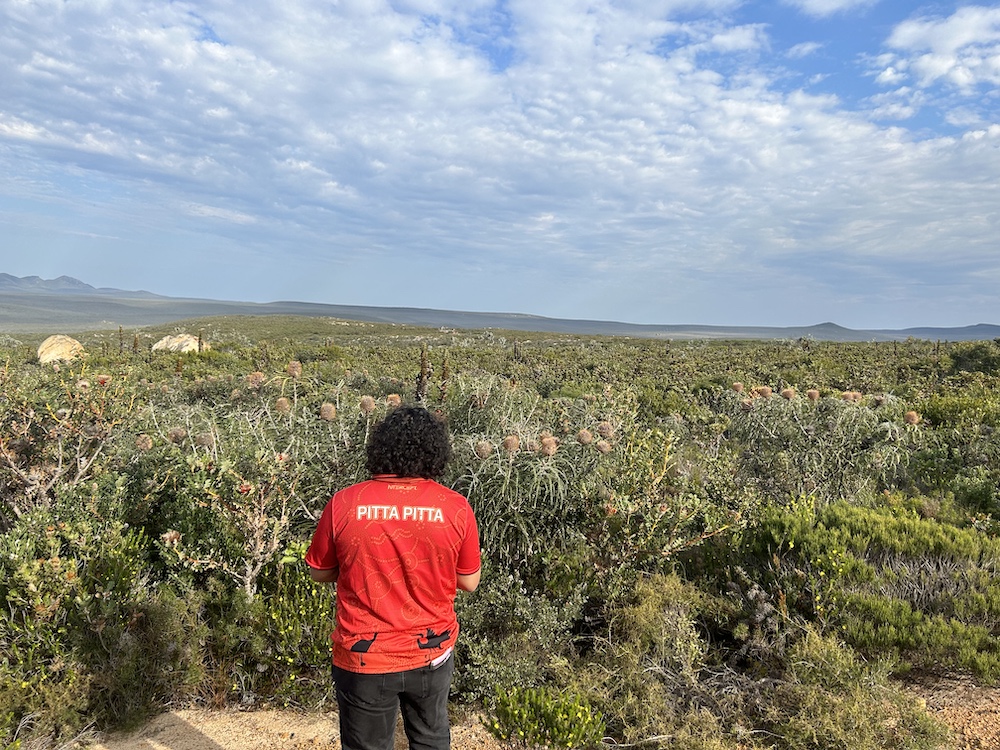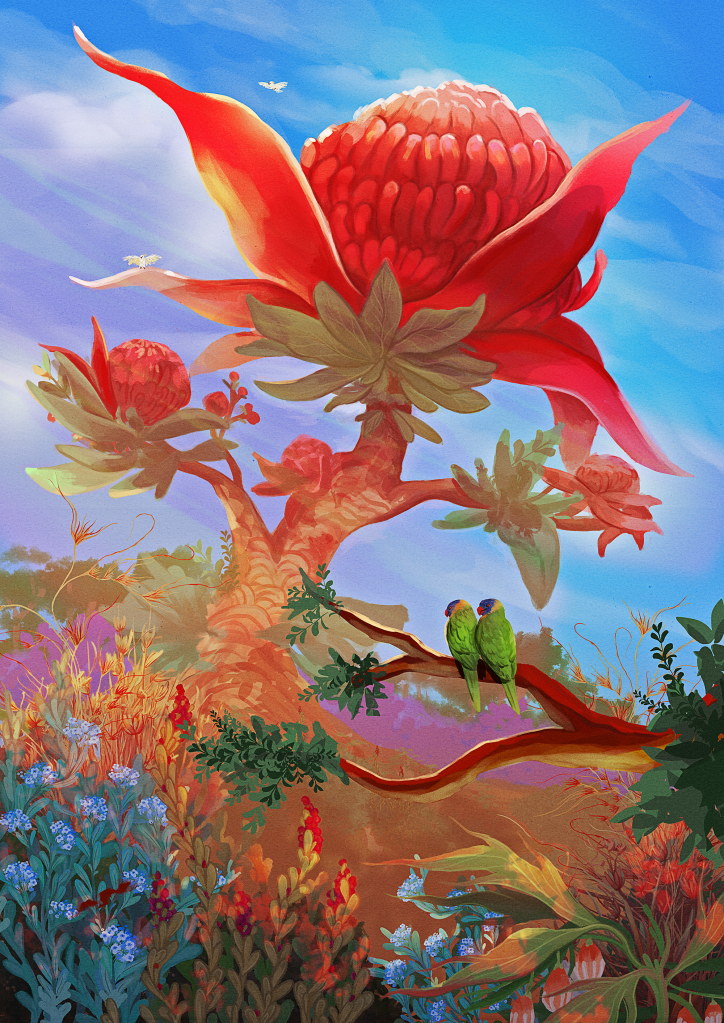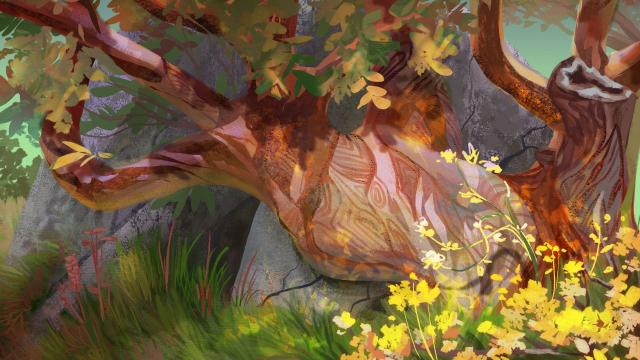I don’t know if I’m what many would call a ‘gamer’ per se. Sure, I’ve had my bouts with Fruit Ninja, Subway Surfers and Mario Kart, but it wasn’t until the rise of game-turned-hit-series The Last of Us that I started thinking about games as storytelling.
As an Aboriginal person, I know the importance of stories; oration, song, dance, art and the landscape carry messages that ground our living cultures. Video games had never struck me as a space where our storytelling tradition could thrive until I met some of the GUCK team at SXSW, who are currently developing Australia’s first Aboriginal-led mobile game.
Sitting down with Naarm/Melbourne-based Lead Game Designer Phoebe Watson (Gunditjmara) and Junior Game Designer & Associate Game Runner Elijah ‘Eli’ McDonald (Noongar/Yamatji/Pitta pitta/Murrawarri/Kurrawali), we were able to spin a yarn not just about their upcoming game but the importance of designing for a Black audience as First Nations practitioners.

The mobile game is a project “65,000 years in the making,” but is still finding its name. Amongst ourselves, it was affectionately referred to as “The Game”. In Standard Australian English, this might sound dismissive but, in Aboriginal English, it is anything but. Being referred to as “The” anything means that you are so important in the context that no one could mistake who or what was being spoken about.
The Game takes place in a landscape that is familiar but fantastical. Eli explains that, through the team’s own lens, “it’s sort of inspired by Australia, but still an abstracted kind of fantasy, so it’s not any specific place in Australia”. Through mini-games and planting native flora, the player navigates different levels of “restoring and healing Country, rewilding and rebuilding the natural ecosystems of this world”.
In a classic Blackfella way, the story of The Game is also about reaffirming the relationship between people and Country. Phoebe tells us that the role of the player is “supporting Country to fight back and flourish. We’re trying to decentralise the player as the hero/saviour and make it a more collaborative experience with the natural environment.”

Initially, I assumed that this message was designed to challenge non-Indigenous players. Phoebe and Eli were quick to correct me: The Game was designed with Mob as the primary audience, including having all regional game testing to date being Mob only so they could take action on community feedback first.
“Seeing these kids have an opportunity to do games, play testing. It’s really not something that our communities would ever get to really experience. Bringing something like this to kids so they can be a part of that process, I’d be so stoked if I got to do that when I was young”, Phoebe tells me.
“That is just showing them that what they create can be cultural. It doesn’t have to be the typical paintings or stories or dances, it’s just a totally new medium that we could be expressing our culture with.”
Eli affirms that he’s “trying to design something that’s fun for my little cousins and siblings and just the broader community. Keeping elements of our stories and using that as the inspiration for what we create, that gives those kids something to connect to. It’s not this abstract, random game.”

The Game is also slated to be completely free, to open up access to as many players as possible. A mobile platform was a specific choice due to the fact most people have a phone but not a PC setup or gaming consoles.
One of Eli’s favourite feedback sessions from the regional testing was with his Nan. “She was saying she could see Country and, even though it didn’t look exactly like where we’re from, she could still see those elements.”
This familiarity is likely due, in part, to the unique design process the GUCK team has undertaken. Led by a Mob-majority team, GUCK has undertaken community consultations, worked with Elders, and even made field trips to team members’ ancestral homelands for inspiration.
“The community support that GUCK has provided us and me has been integral to my ability to create without fear”, Phoebe explains. “Something I wish that I was told about when I was approached to kind of integrate my culture into games was the concept of ‘cultural load’. Where we are asked to make decisions for a whole community, which is something we don’t have to do at GUCK.”
Eli followed on about being isolated in the past as “the only Blak guy in the course or on the campus [in Perth]. When I was studying, the idea of culture even being anything near what I was working towards just wasn’t in my mind at all. I didn’t know people like Phoebe existed, I wish my lectures told me.”
Despite knowing how far the industry has to come, Eli and Phoebe speak to the challenge and joy of creating The Game.
Phoebe tells me that, in challenging common gaming tropes, the team have had, “extra considerations to make. It’s a game about Country and interacting with Country. What does that mean for a non-Indigenous person to be put in that headspace as well? Balancing all this stuff has been such a challenge for me as a designer, but I’ve loved every second of it and it’s just been really kind of invigorating to come up with new mechanics.”
Eli says the most exciting aspect of the project is that “after this game, other Blak people coming through have that point of reference now. They can look at what we’ve done and maybe even fix or improve upon the things that we’ve done, because it has taken quite a while to get to this point. It requires a lot of time and the next time won’t need to take as long.”
Above all else, Eli says he is “just excited about the future of Blak Games and on top of that, just Mob having a cool experience, something that centres and sees them.”
You can follow GUCK on Instagram, Twitter and TikTok to follow future development of Australia’s first Aboriginal-led mobile game.
Lead image: GUCK

Leave a Reply